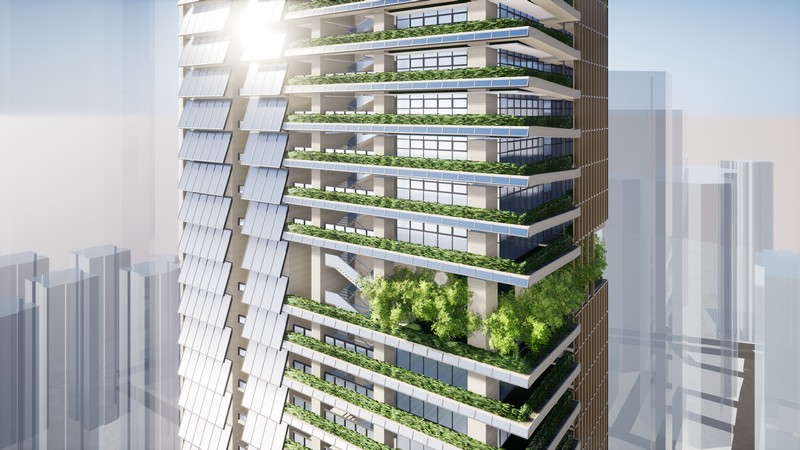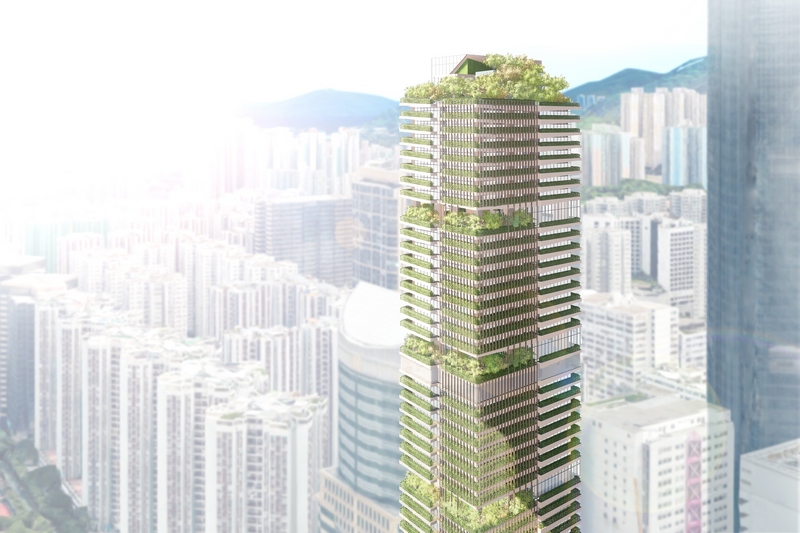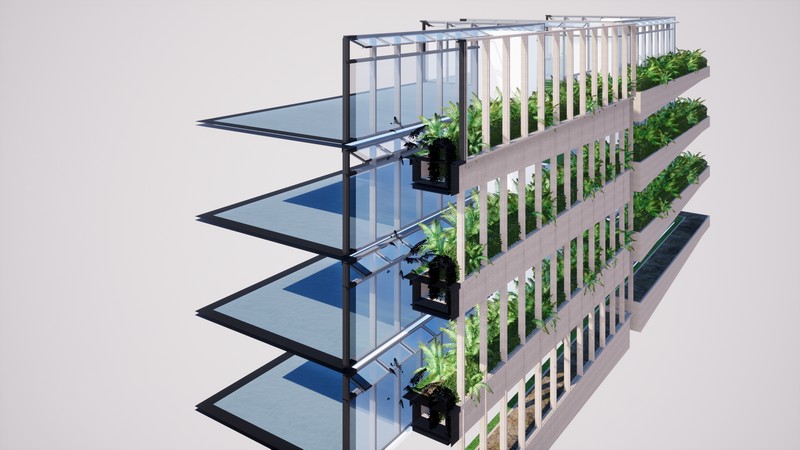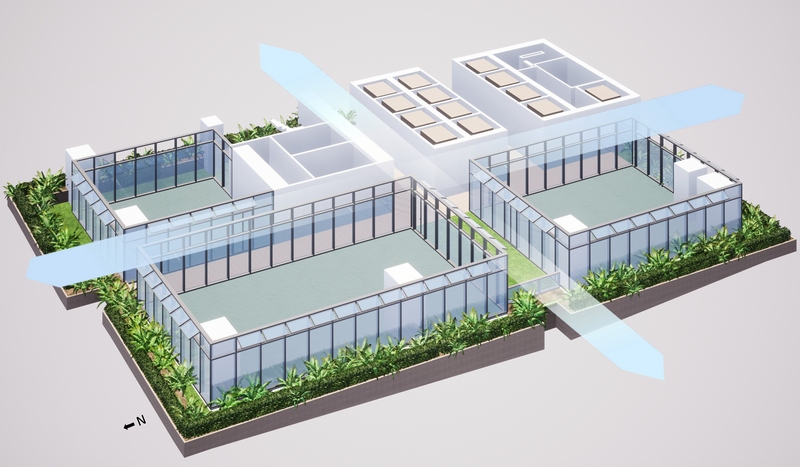Retrofit proposal by LWK + PARTNERS turns high-rise office building into urban forest paradise
The threat of climate change is imminent, and we must act fast. In Hong Kong, China, commercial buildings currently take up the highest percentage of electricity use and its ageing building stock is seriously holding back the city’s transition to carbon neutrality by 2050. LWK + PARTNERS, one of the city’s leading architectural practices, recognises an urgent need to reduce carbon emissions throughout the whole building life-cycle and works actively to respond.
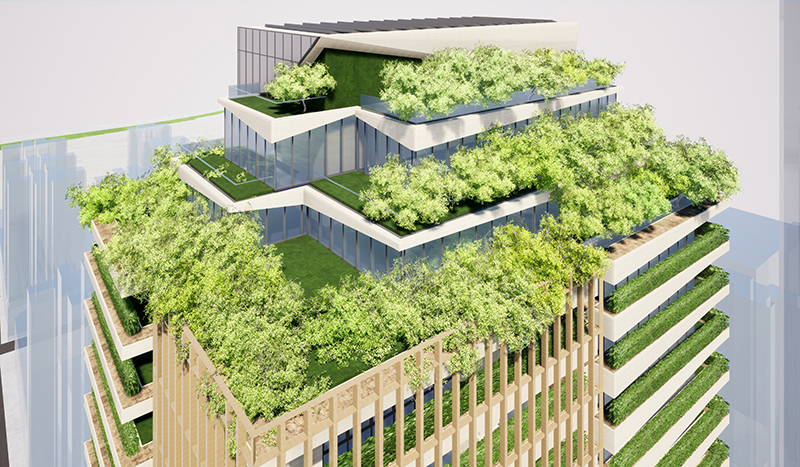
It recently won a Merit award in the Hong Kong Green Building Council’s Advancing Net Zero Ideas Competition with a future-ready retrofitting proposal for Oxford House, which envisions to turn the office building into an urban forest paradise in a high-rise, high-density city context, promoting thermal comfort and wellbeing while significantly cutting down on energy consumption through active and passive design strategies.
While much discussion in the industry focuses on new buildings, attempts to upgrade existing buildings into green, energy-efficient structures has a great potential to revolutionise the way our cities approach sustainable development by keeping both embodied carbon (by reusing building materials) and operational carbon (by changing how the building operates in the future) in control. The firm’s design proposal for Oxford House has provided timely insights on the topic.
Minimising heat gain
The first step for lowering energy use in buildings is to reduce heat gain. LWK + PARTNERS proposes to reuse and convert the existing façade of Oxford House into a green façade with a setback design. The façade is set back while leaving the floor slab extent unchanged, resulting in projecting floors that double as a shading device for the floors below. This reduces the need for new material for building shading.
The setback also creates a double-skin façade, which consists of an external glazing, an intermediate cavity and an inner façade. The external glazing provides protection against weather, while the intermediate cavity would act as a thermal cushion with planters for additional shading and solar absorption. The inner skin, which is the existing low-e external glazing, protects against indoor thermal losses and facilitates the control of permeability for natural ventilation. To produce a stack effect, which enhances natural ventilation, voids are opened in existing floor slabs to allow for hot air to move up creating negative pressure to draw the air inside.
Pushing back the line for energy consumption area
As air-conditioning is a major source of energy consumption, pushing back the line for air-conditioned area is a major sustainable design strategy. In response to Hong Kong’s subtropical climate, LWK + PARTNERS proposes a hybrid ventilation approach for Oxford House involving a combination of natural ventilation and auxiliaries. The ground-floor entrance space is fully opened up to omit air-conditioning altogether, a pair of escalators is replaced by stair seating and an existing connection is turned into a semi-open Green Link. Cross ventilation is encouraged in common areas like entrances, lobbies and shared corridors, through operable openings and open façades.
The design also recommends a range of active gears to maximise thermal comfort. To improve the air ventilation in the car park or foyer, a black-painted solar chimney can be introduced to quickly heat up the air inside, create an updraft of air and draw it outside, increasing air circulation and cooling the building. Other energy-saving devices may include big ceiling fans, reflective pools, and anidolic light pipes which capture daylight and transfer it to indoor spaces.
Integration of renewable energy systems
In the future, low-carbon or even zero energy buildings will not only be defined by the amount of energy they save, but also how much clean energy they generate to offset their own consumption.
One way is to install a diversity of photovoltaics (PV) to generate solar power. Bifacial panels generate power from both sides of the panels while acting as shading devices. They should ideally be installed on white reflective surfaces for utilising the rears. Building‐integrated Photovoltaics (BIPV) maximise sunlight reception by using PV panels as construction materials for the building envelope including the façades. It is an immediate cut-down on the materials cost and requires minimal care and maintenance compared to conventional materials like tiles and glass, therefore lowering the long-term life-cycle cost. Solar tiles can even double as roof tiles and PV panels, with finishes that can mimic the appearance of stone or ceramic tiles.
Maximising active carbon conversion
Designing buildings with extensive greenery and landscaping can maximise active carbon conversion. Communal sky gardens with open-sided areas allow cross ventilation to mitigate the heat island effect while enhancing the building’s visual permeability. Green roofs, edge planting and vertical greening also work as a natural air-filtration system for the health and wellbeing of occupants.
To raise people’s awareness and participation of low-carbon living and waste recycling, spaces can be reserved for urban farming and low-carbon restaurants to popularise the concepts of shorter supply chains, less packaging, lower energy consumption and reduction in food waste. Occupants can be encouraged to take part in electricity generation through energy floor systems which turn footsteps into electricity, which could then be used on things like smartphone charging packs for occupants.
Energy and waste management
Much energy and materials in daily building operation are wasted due to lack of management. The energy management programme that LWK + PARTNERS proposes for Oxford House includes high-efficiency LED lighting, solar-adaptive window blinds with automatic shading system, regenerative lifts, AI-based energy optimisation solution (AI-EOS) for HVAC system, high-volume low-speed fans or displacement ventilation with temperature setback, and chilled beam system plus raised floor displacement ventilation.
To minimise wastewater emissions, low-flush toilettes and dry urinals can be installed, while alternatives to fresh water sources include rainwater harvesting and greywater reuse.
Our high-density urban habitats are now packed full of inefficient built structures in want of redesign and upgrades. To advance net zero, future architecture must take more heed to remodelling or modifying existing buildings as much as building greener new ones to cut back energy consumption.













